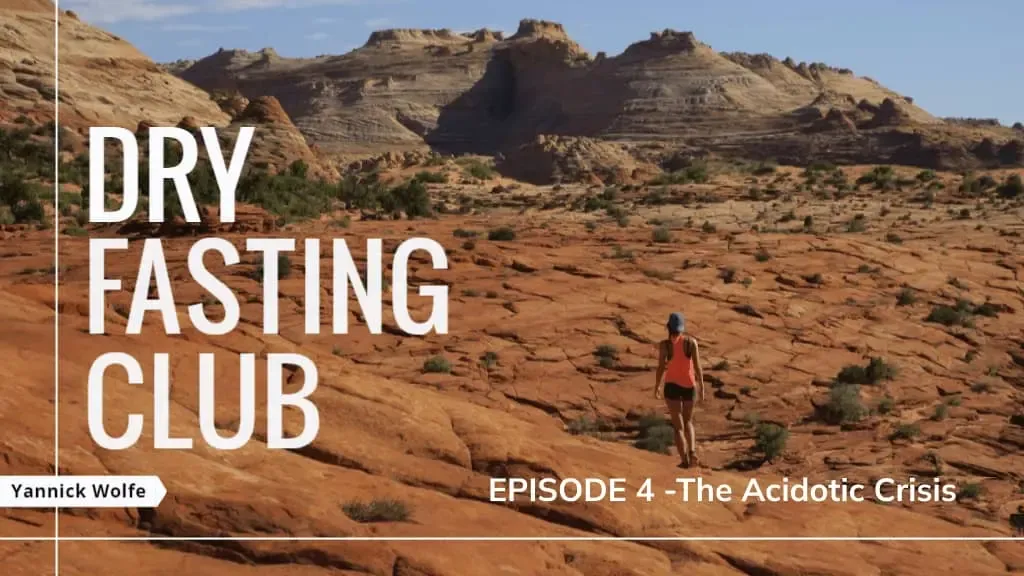The Acidotic Crisis (or Metabolic acidosis) is the term for a process where the chemical balance of acids and bases in your blood goes all out of whack. This means your body is either making too much acid or it’s just not getting rid of enough of it. It might also mean that your body just doesn’t have enough base to offset a normal amount of acid.
If you are looking for a more personal version of the acidotic crisis based on personal experience, theories, data tracking, and Filonov's knowledge, then make sure to read this Acidotic crisis article as well.

What is dry fasting?
Dry fasting is a type of fasting where individuals abstain from both food and water for a certain period. Unlike traditional fasting, which restricts food intake, or water fasting, which restricts water intake, dry fasting requires the body to rely on its internal water reserves and metabolic reactions for energy. With roots dating back to ancient times for religious and spiritual purposes, dry fasting has potential health benefits such as reducing inflammation, improving metabolic health, and increasing longevity.
However, the risks, including dehydration, kidney stones, and urinary tract infections are there if you don't approach it correctly. Dry fasting durations vary, with some people opting for 24-hour fasts while others choosing longer periods.
It is crucial to stay hydrated before and after dry fasting and to consult with a medical professional beforehand, especially if one has underlying health conditions. When done properly, dry fasting can contribute to overall physical and mental well-being. It is the strongest type of fasting available, and some healing mechanisms can only occur while dry fasting. A 7-day dry fast is comparable to a 21-day water fast.
Whatever the reason, the chemical reaction that occurs within the various systems of the body just isn’t functioning properly. When this happens it can inhibit cell growth and health and create several problems that will need medical treatment.

Metabolic acidosis can range from mild conditions to acute or chronic severe episodes that can be life-threatening. On a clinical level, it is treatable, but you must first find out what is causing it. With any health condition, it is always best to talk to a professional medical practitioner to ensure the conditions aren’t serious and can be treated right away.
Causes of Metabolic Acidosis
Metabolic acidosis is the result of an imbalance of acid in the arterial blood, and there are several different reasons for this to happen. Let’s take a look at the main reasons for the acidotic crisis.
Fasting Ketosis
When you fast, the longer you go, the deeper you enter into ketosis. This means that more and more fat is burned and converted into free fatty acids. This raises the pH of your blood. Your body needs to buffer it.
These are all normal things during fasting. However, there are other ways that metabolic acidosis can occur when you have diseases or underlying conditions. Some of them are listed below.

Ketoacidosis
When a person has diabetes, is dehydrated, or doesn’t get enough insulin, they start to burn body fat for fuel instead of carbs. When this happens the body makes ketones. If you have reserves of ketones in your blood it can turn acidic and create a condition called ketoacidosis.
A build-up of ketones is a common occurrence in people who consume a lot of alcohol over long periods of time without eating enough food. But an overload of ketones in the blood can also happen when a person stops eating altogether.
It is important to closely monitor the onset of ketoacidosis before it starts to create serious problems for your health.
Lactic Acidosis
Lactic acid is produced by the cells in your body when there is not enough oxygen to use. One of the most common reasons lactic acid or lactic acidosis builds up, is if you’re performing strenuous and intense exercises.
However, lactic acid can also build up if your experience big drops in your blood pressure, cardiac arrest, heart failure, or are suffering from a really bad infection.
Renal Tubular Acidosis
If your kidneys are functioning properly they remove acids from your blood and eliminate them every time you urinate. However, if a patient is suffering from kidney disease, or has an immune system and genetic disorder that can damage the delicate mechanisms of the kidneys, the end result might be too much acid in the blood. This is called renal tubular acidosis.
Hyperchloremic Acidosis
Hyperchloremic acidosis means that there are low levels of bicarbonate occurring. A person with low levels of bicarbonate may experience severe diarrhea or kidney problems. Bicarbonate is the base that helps neutralize the acids in your blood.
Respiratory Acidosis
Respiratory acidosis occurs when there is a problem with how the lungs function and your body has too much carbon dioxide. When this happens, the end result is blood that is too acidic.
Symptoms of Acidotic Crisis
Although patients experience different symptoms ranging from acute to chronic when in a metabolic acidosis crisis, the most common symptoms are:
- Rapid or shallow breathing
- Rapid or irregular heartbeat
- A headache
- Confusion or impaired brain function
- Muscle weakness
- A feeling of tiredness or acting sluggish
- A decreased appetite
- Nausea or an upset stomach
- A fruity-smelling breath. This is a classic symptom of diabetic ketoacidosis (DKA).
If you are experiencing nausea, headaches, weakness or any of these other symptoms, call your doctor immediately. This is the body’s way of telling you that something is wrong and it could be a sign that there is a more severe problem that needs medical attention.
Reaching the peak
If you’ve ever extended water fasted, tell me if this rings a bell. Starving on the second and third day, constantly thinking about food. You’re weak, you have headaches, and you feel like vomiting for the next 5 days. Why does this happen?
It’s because your body is slowly acidifying and moving steadily towards the acidotic crisis peak. It’s this Acidotic crisis, that once over, you finally feel like a million bucks. You hear people saying things like oh after a few days I felt amazing!
While dry fasting, the body undergoes a much stricter and harsher condition than if they were just water fasting. The body gets into a bit of a crisis because it lacks not only food but also water. This makes it so that the body has to scramble quite quickly to produce water and energy. Where is that located? Our fat cells!

The Acidotic Crisis in Research
For dry fasting, a lot of research over the years from Russia discovered that the first acidotic crisis usually occurs around the 3rd day of dry fasting. Then it subsides and levels out for a few days. The second acidotic crisis appears around days 9-11. This is the one that supposedly provides the strongest healing. On dry fasting retreats, they aim to reach the second acidotic crisis, but it’s important to note that this is done under strict supervision.
You’re definitely not recommended to go longer than 5 days by yourself, even though lots of dry fasters do up to 7 days at home. With a lot of experience and fasts under your belt, this is very doable.
However, recently, some dry fasting experts have started looking at fractional fasting and combined fasting as a way to avoid having to go 9+ days. This means that multiple 5-day fasts can work just as well as one 9+ day dry fast if done correctly and within a shorter time span.
Without going into too much detail, refeeding is very important in between fractional fasts. You’ll want to look up an episode that talks about refeeding and adjust it as best as possible to your situation. Check out the dry fasting club protocols for different refeed versions and find one that works for you.

How Does Chronic Acidosis Cause Disease
Chronic metabolic acidosis can lead to serious health problems. Some of these can be prevented through a carefully monitored wet or dry fast, and your fast should be monitored by a professional healthcare practitioner.
They will monitor you during the fast to ensure a level of success in balancing out your PH level without putting too much stress on the systems of the body. Here are some of the problems that can occur from metabolic acidosis:
- Osteoporosis – A loss of bone density and calcium that can increase the risk of fractures and breaks.
- Growing problems in children -Metabolic acidosis can restrict the growth hormone.
- Increased kidney damage – Chronic kidney disease can get worse.
- Muscle loss – Reduced muscle mass or wasting can occur.
- High blood sugar – Blood sugar levels can be elevated. – the onset of diabetes.
- Endocrine system problems – The endocrine system is glands that create hormones that can lead to insulin resistance and possibly diabetes.
- Increased risk of death
It's very important to be aware of the potential dangers of dry fasting. A lot of them are discussed in the article Dangers on dry fasting below. If you know what you are dealing with and the mechanisms behind it, it makes for a much better dry fast experience.

Complications from other types of metabolic acidosis may also include osteoporosis. Osteoporosis happens when the kidneys and lungs are unable to get rid of excess acid. The body starts to pull calcium from the bones to neutralize the acid. A loss of calcium can weaken the skeletal system and affect other systems.
Why do we want to reach The Acidotic Crisis for healing during fasting?
Although the acidotic crisis is not perfectly understood from a scientific perspective, we know that its a phenomenon that occurs in everyone, to varying degrees.
Nearly all doctors who use extended fasting therapeutically, agree that this is an important step in the autophagic healing process.
It’s true, most of these doctors are from Russia, but its because dry fasting and therapeutic water fasting has been studied much more extensively.

As new studies come out, they start to show us that there are NEW autophagy mechanisms activated during dry fasting. How crazy is that?
Absolutely unexplored autophagy that triggers stem cell creation. This makes me realize how little we really know about the body. Its responses to stressors like cold and heat shock therapy, and the same with water or dry fasting. You start to realize that although scientific methods improve and we start to understand some mechanisms better. We keep finding out that there is more than meets the eye.
Hybrid fasting
Knowing about the importance of the acidotic crisis, you realize that if you’re doing this for healing, and you don’t have a lot of time, it’s crucial to hit those acidotic peaks. This brings us to ideas that different fasters have played around with. The most popular hack to bring about this crisis faster is to dry fast for 3 days, and then continue with water fasting for up to 10 days.
This can be called hybrid fasting or combined fasting. The beauty of doing this is that you get to cut out about 5 days of water fasting, but get the exact same benefits (or possibly more, considering we don’t even fully understand the extra autophagy mechanisms).
The secrets of dry fasting
Another amazing thing about dry fasting, is that the consensus is that you do not need to prepare with cleansing procedures like enemas. Since there is no water, the body does not deposit toxins in the colon the same way it does during water fasting.
That means that there are even more mechanisms internally that are doing a different type of cleansing. You hear people talking about the dry fasting heat, that occurs around day 3+. The way a lot of people look at it is that dry fasting creates an internal combustion furnace inside your cells, and it rips toxins apart on the spot, while also releasing energy.
The study about the microtubule dependant autophagasomal clusters, showed us that there is a deeper autophagy going on inside the cells during a dry fast. This is quite the opposite during water fasting where regular autophagy focuses on finding ‘bad’ cells and destroying them. In dry fasting it seems that it’s done on an even finer scale.
Not to mention that dry fasting has also shown to drastically increase new stem cell counts. I always tell people that the rich are flying to Mexico to get the newest stem cell therapy at 50,000$ a pop, where they’re injected with cultured stem cells from an embryo or fetus. While the poor man’s stem cell therapy can be done at home, and with the biggest advantage of it being your own body producing your own well adjusted stem cells with less of a risk of rejection. No wonder this is a secret art, who would want the world to find out about this?
Possible consequences of acidosis, and when to choose to break the fast?
🎯 Ending the fast
Knowing when to break the fast or not is very important. That is why one of the main things you’ll often hear is that you need to build up your fasting experience. You’ll hear that you should not start with dry fasting, but water fasting. This allows you to start to learn how your body feels when it is fasting.
It’s like when someone starts to learn how to ski, you don’t send them on the mountain slope for their first run. They go to a bunny hill and practice the basics first. There will be many falls, but eventually, they’ll feel ready to ride the mountain.
Remember that the fast is also a bit of a mental game. The Mental state is crucial during a dry fast. Read more about it below.

No one truly knows when to break a fast better than yourself, but without enough experience, you might miss warning signs. It’s always better to gradually increase fasting days. But overall, the general consensus is that if you are in very intense pain, if you are constantly lightheaded, or if have very high blood pressure when sitting still you should end the fast and try again at a later date after refeeding correctly.
🫘 Problems with kidneys
Not enough research has been done on dry fasting and damage to kidneys, although the anecdotal evidence shows that if you don’t have a prior kidney disease, if done properly, the patients heal their sickness, with no kidney injury. There is a study done on 10 healthy individuals who dry fasted for 5 days and were completely fine. We do need more research on this, but as long as you take it slow and listen to your body, you can safely unlock new levels.
Some people worry about kidney stones, and there have been rare occurrences of people passing kidney stones after a dry fast. The argument is that the acidosis helped create a high calcium environment, which is valid.

The counterargument is that its usually people who are already susceptible to kidney stones and have had them growing, and the dry fast is pushing them out. I believe there’s some good points to this, and that if anything, it creates an even stronger reason to make sure you are preparing for the fast with magnesium citrate, lemon water, and baking soda. If you’re really worried about kidney stones, you should really up your citric acid game asap.
Cancer
A 2012 study found a link between diet-induced metabolic acidosis and cancer. Research indicated a possible connection between high acidity levels in the body and cancer. Eating acid-forming foods such as meat and sodium over a long period of time increases acidity in the body.
Although there is not enough research to determine whether diet-induced acidosis alone increases the risk of cancer or whether it has to work in combination with other factors like obesity or other underlying health problems.
How To Find Out If Your Symptoms Are Life-Threatening
In order to determine the serenity of your metabolic acidosis, your doctor can run a few specific clinical tests. These tests are used to review which treatment will be the best to get you back on track.

Anion Gap
The anion gap test measures the chemical balance in your blood. It does a comparison of all the positively and negatively charged particles like chloride, sodium, and bicarbonate. Some metabolic acidosis types will show a bigger difference or “gap” between the positive and the negative particles.
Arterial Blood Gases (Carbon Dioxide)
The arterial blood gases test measures the pH of your blood and how much oxygen and carbon dioxide are present.
Urine Test
A simple urine test can determine whether or not the patient has ketoacidosis. It can also find out several other things like if the person has kidney problems or alcohol poisoning. People dealing with diabetes can test their urine for ketones with specially designed test strips that you can buy at your local pharmacy.
Blood Sugar Test
Blood sugar meters can also measure ketones in your blood.
Treatment of Metabolic Acidosis Crisis
The treatment of metabolic acidosis relies heavily on finding out what’s triggering or causing it. Therefore if a person is avoiding treating those causes, it means they are essentially creating an unbalanced system.
If the initial balance is not restored and levels do not return to normal then it can create serious problems that affect the skeletal, muscle, kidney, and other systems in the body. In some of the most severe cases, a complete breakdown can occur, which leads to system shock and eventually death.
The sooner patients are treated for metabolic acidosis crisis the better. Some of the more common treatments are:
- Detoxification – Patients who suffer from drug or alcohol poisoning will need to treat a ketone imbalance with a detoxification process.
- Insulin – Insulin treatment may be needed if you have Diabetic ketoacidosis (DKA).
- IV fluid Treatment – A treatment given using a needle through a vein in your arm to provide nutrients for patients suffering from metabolic acidosis crisis.
The Bicarbonate Factor
Sodium bicarbonate, or baking soda, is often used as a treatment for patients dealing with certain types of metabolic acidosis. It is the same chemical compound that’s often used to treat heartburn in patients by neutralizing stomach acid.
When sodium bicarbonate is used to help treat metabolic acidosis, it leads to more alkaline fluids in your body. It also decreases acid in your blood and raises the PH level to be more alkaline. A doctor may give you bicarbonate treatments either by an IV or as an oral medication.
A 2014 clinical study showed that bicarbonate is a great way to treat a highly acidic system. It replenishes the sodium bicarbonate reserves in your system. It also assists with bicarbonate production in your system to level out the PH in your blood.
According to a controlled clinical trial from 2019, metabolic acidosis bicarbonate is perfectly safe for people with kidney disease, but it may also help improve kidney function and extend a person’s lifespan.
Prevention
It might be difficult to prevent the initial stages of metabolic acidosis, but there are a few things you can do to keep acid levels at bay or prevent acid production in the system.

- Water – Drink plenty of water throughout the day. Urine will be clear or light yellow when enough water has been consumed. If water consumption is low, then a person’s urine will be darker.
- Alcohol – By keeping alcohol consumption low, it decreases acid buildup. Patients who consume alcohol see an acid build-up, but they also experience dehydration.
- Diabetes – To keep sugar levels normal, a dry fast will use up the stored carbohydrate reserves in the body of a person and prevent triggering the onset of diabetes.
- Medications – Always review carefully and follow the instructions on your medications. It is always recommended that you speak to your doctor if any serious side effects occur while taking the medications or if you stop taking prescribed medications.
Is it Safe to Enter The Acidotic Crisis?
The answer is both yes and no. For the health and safety of those choosing to fast and enter into metabolic acidosis, it should never be done all by yourself. Even doctors who fully support dry or wet fasting methods suggest that long-term fasting of 3 days or more should be done under strict supervision.
The main reason for long-term fasting supervision is mainly for safety. During the fast, the body will go through moments where certain chronic diseases feel worse, like renal colic. A doctor would have to decide whether or not to allow the fasting to continue or treat the symptoms. Another reason for supervision during a long-term fast is that a doctor will know when it is best to stop the fast so that you achieve the maximum health results for a better PH level.
It is relatively safe to enter into metabolic acidosis, but the key is to always start slowly. Doing short-term fasts initially gets the body conditioned to the feelings associated with fasting, but also allows the person to stop if the feelings get to be too much.
When Does the Acidosis Crisis Occur During Fasting
Whenever someone changes how or what they eat, there is bound to be a change. But, not everyone will experience the same things at the same time. This is true of dry fasting stages.
Regardless, most will experience a mild acidotic crisis kick in around the 12 – 14 hour mark. While others would need a full 24 hours to see results. Although these are approximate figures, there might not be much of a notable difference in the blood PH level at this time, and you could still results higher than 7.3.
The Acidotic crisis that is talked about in prolonged dry fasting and water fasting is said to arrive around day 3 for dry fasters and day 7 for water fasters. This is why the claim that dry fasting is 3x more powerful than water fasting comes from.

Healing Benefits of the Acidotic Crisis During Fasting
Fasting triggers an acidotic crisis. While some people experience only mild symptoms, others may experience more severe symptoms. The most common symptoms are:
- Dizziness and weakness
- Headaches
- Nausea
- Darker urine
- A layer of plaque covers the tongue
- The person releases a sharp smell of acetone from the mouth and skin
- Mood swings
As the body slowly moves away from the stress of digestion, the symptoms also slowly start to creep in. But once the onset of the crisis is over, these conditions begin to improve.
For example, a person who may have had signs of weakness or dizziness as the acidotic crisis peaks will develop renewed strength and better balance coming out on the other side of it.
Another example is a person suffering from headaches who no longer has any pain in their head. While someone else may have felt nauseous now has a settled stomach. One thing to note is that with a dry fast the dark color of urine will remain until the person starts to introduce water which will lighten the color of the urine.
Renewal
The smell of acetone and the layer of plaque on the tongue decreases and a person’s mood starts to become more steady and pleasant. During this time the body is going through a process of renewal, cleaning, and healing the cells and organs. A dry fast means the body’s energy is mostly used to rejuvenate the body and help the systems recover from abuse from high-acidic foods.
Weight loss
Let’s not forget weight loss. As the body’s tissues and cells break down fat and rebuild, one of the most noticeable signs that the dry fast is working is losing weight. Hard-to-reach places on people’s bodies such as the neck, arms, and waist see initial weight loss. Therefore it is safe to assume that fat cells are being targeted in other areas.
Inflammation
Inflammation is a problem with many adults, and it can cause severe problems for several systems in the body such as the circulatory system. As a body goes through a dry fast, multiple mechanisms such as ketone bodies, restricted calories, and gut microbiota modifications may help modulate inflammation and reduce inflammation-related illnesses.
Acidosis and electrolytes imbalances
What does all of this mean? Well, an acidic state does result in electrolyte imbalances, that is quite clear. Acidosis is often accompanied by hyperkalemia, which means excessive potassium. If you’re thinking wait, isn’t potassium alkalizing? Yes, but read on.
Potassium in this case, moves from the intracellular (inside the cell) to the extracellular (outside the cell) and most of it is released in the urine. So you’re losing it. The same can be seen for hypercalcemia and hypermagnesemia, which is too much calcium and magnesium.
Mentioned electrolytes have an alkalizing effect on the body, so it goes to show further proof of how well your body can adapt to stresses and balance your PH. These states occur through extracellular shifts. It means that it’s being taken out of the cells and into the surrounding acidic environment to fight it.
Think of it as your bones, muscles, and all your cells floating in a vat of weak acid. They won’t disappear right away, but they will slowly get dissolved more and more until the acid is neutralized. If you keep adding acid slowly into the vat, without enough alkaline materials, like in the case of a slightly acidic body, the leaching and dissolving will continue. So now it starts to paint a clearer picture.
Some good solutions to acidosis
What can we do if our lifestyle is creating an acidic environment in the body? Most people will tell you to get an electrolyte panel blood test done. But you need to remember that blood level electrolytes are not a good indication of deficiency or not.
To get an accurate view you’d actually need to monitor the ingestion amount of electrolytes and the urine excretion amount of the electrolytes. Blood levels do not account for the electrolytes primarily residing inside your cells.
Think of it this way: if your body is releasing electrolytes to balance the acidosis in your body, it will show that you have high levels, or even normal levels, of them on a blood test. Even though your levels inside the cells are suffering and deficient. This could create a situation where your doctor says everything looks great, you should be fine! But in reality, you feel terrible, and don’t know that your electrolyte levels are actually suffering.
💊 Supplementing Electrolytes
Taking in higher levels of Minerals such as potassium, magnesium, and calcium have an alkalizing effect on the body. They’re very necessary to help maintain your body’s ph buffer system. If you’re deficient in them, you can create a positive feedback loop which is bad.
These minerals have an even more pronounced alkalising effect if they are bound to citrate. For example as potassium citrate or magnesium citrate. As I mentioned earlier, magnesium citrate has been a game changer for me after fasting.
I have also started taking it a few times a week before bed. I take magnesium l-threonate when I wake up as it’s the most bioavailable for the brain and it does not cause grogginess. Magnesium is also essential in calcium absorption, so I rank it as one of the higher value electrolytes. Most people who are magnesium deficient are also deficient in potassium. It is necessary for almost every cell function including the making of stomach acid, so there’s that as well.
🍔 Don’t drink during meals
Study after study has shown that if you drink during a meal you dilute your stomach acid, which is needed to properly absorb minerals and digest your food. What this meansis that acid is just as important as alkaline minerals. Without strong stomach acid, your digestion and its cascading features get negatively affected. So stay away from antacid pills and high doses of baking soda. Even if they make your acid reflux feel better, you may actually be causing more chronic problems down the line.
On top of all that, our food is grown in nutrient-depleted soils, so right off the bat, a lot of food is less nutrient rich than it used to be. The longer the food is transported, the less nutrients it has.
In fact, most produce loses 30 percent of nutrients three days after harvest. Keep in mind this is mainly vitamin loss when the vitamins get oxidized. These are all compounding effects that we all need to be aware of.
Conclusion
Going through a complete dry fast for approximately 72 hours or less is perfectly safe and the benefits of entering a ketoacidosis crisis can help a person in several ways. It is perfectly normal to feel off for a period of time leading to the onset of the crisis. Your system is trying to do its thing and deals with leveling out the acid in your body.

Talk to your doctor before you start a dry fast or a water fast. They will know how to monitor your fast period and offer treatment if problems persist It could be a sign that you are doing the fast incorrectly, or you are not paying attention to the correct timeframes to complete the fast properly.




